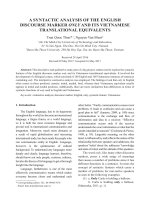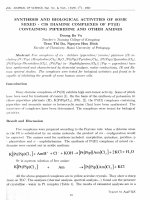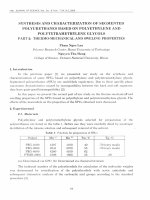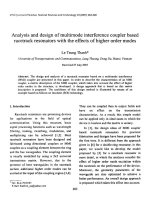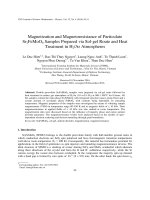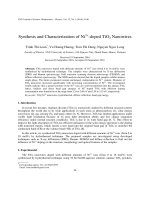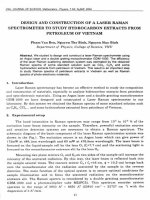DSpace at VNU: Synthesis and characterization of three-arm star-shaped conjugated poly(3-hexylthiophene)s: impact of the core structure on optical properties
Bạn đang xem bản rút gọn của tài liệu. Xem và tải ngay bản đầy đủ của tài liệu tại đây (792.35 KB, 11 trang )
Research Article
Received: 10 April 2015
Revised: 23 June 2015
Accepted article published: 10 July 2015
Published online in Wiley Online Library: 23 July 2015
(wileyonlinelibrary.com) DOI 10.1002/pi.4966
Synthesis and characterization of three-arm
star-shaped conjugated
poly(3-hexylthiophene)s: impact of the core
structure on optical properties
Ha Tran Nguyen,a,b* Trung Thanh Nguyen,a Le-Thu T Nguyen,a Thang Van
Le,a,b Viet Quoc Nguyen,c Thu Anh Nguyenc and Anh Tuan Luua
Abstract
Star-shaped molecules consisting of regioregular poly(3-hexylthiophene) (P3HT) chains as the arms, attached to either a
propeller-like triphenylamine or a planar triphenylbenzene core, have been synthesized via Suzuki coupling. The structures of
the three-arm star-shaped poly(3-hexylthiophene) (s-P3HT) materials obtained were studied using Fourier transform infrared,
1
H and 13 C NMR, XRD, gel permeation chromatography and DSC. The s-P3HT polymers were soluble in common organic solvents
and exhibited number-average molecular weights of 6000–7200 g mol−1 . Their optical properties in solutions and in solid state
films were investigated using the UV−visible absorption and photoluminescence techniques, and were compared with those of
linear P3HT.
© 2015 Society of Chemical Industry
Keywords: poly(3-hexylthiophene); triphenylamine; triphenylbenzene; star-shaped conjugated polymers; Grignard metathesis (GRIM)
polymerization
INTRODUCTION
Extensive research has been devoted to the design and construction of nonlinear two- and three-dimensional conjugated
macromolecules with star-shaped, disk-like and hyperbranched
structures as multifunctional molecular architectures.1 – 6 Normally, 𝜋-conjugated polymers and oligomers are one-dimensional
chains with large anisotropy. This facilitates the efficient movement of charge carriers and excitons through the backbone when
𝜋-orbital delocalization occurs along the conjugated polymer
chain.6 However, the migration of these species in the two other
directions is slowed down. Moreover, one-dimensional conjugated
structures tend to be disordered in the bulk and show a large
anisotropy in aligned systems. Hence, increasing the dimensionality of conjugated systems into a second dimension is often
required.7 – 11
Polym Int 2015; 64: 1649–1659
In contrast, the core-first method is used to prepare a reactive
core that can initiate the polymerization of monomers to form
arm chains.24 – 26 Triphenylamine (TPA), triphenylbenzene (TPB)
and their derivatives have been widely investigated as core units
resulting in star-shaped conjugated polymers with good optical
properties and p-type charge transport mobilities, which allow
their use as hole-transport layers in organic field-effect transistors
(OFET), organic solar cells (OSCs) as well as organic light emitting
diodes.27 – 30
∗
Correspondence to: Ha Tran Nguyen, Faculty of Materials Technology,
Ho Chi Minh City University of Technology (HCMUT), Vietnam National
University, 268 Ly Thuong Kiet, District 10, Ho Chi Minh City, Vietnam.
E-mail:
a Faculty of Materials Technology, Ho Chi Minh City University of Technology
(HCMUT), Vietnam National University, 268 Ly Thuong Kiet, District 10, Ho Chi
Minh City, Vietnam
b Materials Technology Key Laboratory (Mtlab), Vietnam National University–Ho
Chi Minh City, 268 Ly Thuong Kiet, District 10, Ho Chi Minh City 70000, Vietnam
c National Key Laboratory of Polymer and Composite Materials–Ho Chi Minh
City, University of Technology, 286 Ly Thuong Kiet Street, District 10, Ho Chi Minh
City, Vietnam,
www.soci.org
© 2015 Society of Chemical Industry
1649
Star-shaped conjugated polymers are a class of nonlinear polymers. They have been paid much attention because of their
compact structures and high segment densities. These features
affect the crystalline, mechanical and electrical properties and
give rise to interesting properties such as suppressed fluorescence quenching in the solid state and improved light-harvesting
ability.12 – 18 Generally, star-shaped conjugated polymers comprise
several linear polymers as arms joined together through a central
structure as a core. Depending on the bonds between the arms
and the core, they can create one of several different shapes. If
the arms are rigid-rod, a flat inflexible core normally provides an
overall two-dimensional geometry, whereas a non-planar center
results in a three-dimensional architecture. To prepare star-shaped
conjugated polymers, there are two strategies: the arm-first
method and the core-first method. In the arm-first method, linear
arm polymers are synthesized first and subsequently end-group
functionalized in order to be attached to a reactive core.19 – 23
www.soci.org
In this respect, Paek et al.31 have reported the synthesis via
the arm-first method of star-shaped macromolecules with
fused TPA as the core and three arms comprising dithieno(3,
2-b;20,30-d)silole, benzothiadiazole and hexylterthiophene units.
These materials exhibited efficient p-type semiconducting performance in solution-processed OFETs with a hole mobility and
on/off ratio of 7.6 × 10−3 cm2 V−1 s−1 and 5 × 106 , respectively.
Niamnont et al.29 have presented a series of TPA-based fluorophores containing multiple pyrene and corannulene, which
were capable of detecting 2,4,6-trinitrotoluene on the nanogram
per square centimeter scale. Recently, Hu et al.32 have reported
two novel star-shaped donor–acceptor small molecules with TPA
as the core, benzothiadiazole as the arm, and alkyl cyanoacetate or
3-ethylrhodanine as the end-group. The films of these molecules
exhibited broad absorption bands from 300 to 850 nm with optical bandgap around 1.6 eV. OSCs based on these materials had
a power conversion efficiency of 1.79%.32 On the other hand,
regioregular poly(3-hexylthiophene)s (P3HTs) have attracted significant interest owing to their potential in a variety of applications
including field-effect transistors, optical sensors, smart windows
and OSCs.33,34 A star-shaped P3HT has a different topology in comparison to a linear one, offering different characteristic physical
properties such as chain aggregation, solubility, thermal and optical properties.35 In addition, the star-shaped P3HT architectures
are predicted to self-assemble into desirable nano-morphologies,
thus giving a solution to the improper morphology issue of active
layers in optoelectronic devices.36 With this in mind, star-shaped
P3HT materials are quite exceptional and provide an interesting
subject for current research. However, a still unresolved problem
associated with the synthesis of star-shaped P3HTs is mainly the
lack of efficient synthetic strategies. Kiriy and coworkers36 have
presented the synthesis of a hairy P3HT by the core-first method.
Nevertheless, the polydispersity of the obtained hairy polymer
was quite broad, 1.98. More recently, Yuan et al.35 have reported a
synthetic route to prepare V- and Y-shaped P3HTs via difunctional
and trifunctional Ni-complex-based initiators bearing biphenyl
spacers, with narrow polydispersities of 1.1 as well as controlled
molecular weights of 8.2 kDa. Despite significant efforts being
made to enable the well-controlled synthesis of star-shaped P3HTs
via the core-first approach, the finding of a suitable core-initiator
and a preparation process for the Ni-complex-based core-initiator
is challenging.
To address these issues, we synthesized via the arm-first
method star-shaped P3HTs (s-P3HTs) comprising a TPA or a 1,3,
5-triphenylbenzene (TPB) core and three branched motifs of P3HT.
The s-P3HTs were prepared via Suzuki coupling reactions between
a TPA/TPB derivative and 𝛼-bromo-poly(3-hexylthiophene)
(Scheme 1). The synthesis and preliminary results on the characterization of the optical and thermal properties of the s-P3HTs are
presented, together with a comparison with those of linear P3HT.
EXPERIMENTAL
1650
Materials
3-Hexylthiophene was purchased from TCI (Tokyo, Japan).
TPA and N-bromosuccinimide were purchased from Acros
Organics (Bridgewater, NJ, USA). Tetrakis(triphenylphosphine)
palladium(0) (Pd(PPh3 )4 ) (99%), [1,1′ -bis(diphenylphosphino)
ferrocene]dichloropalladium(II) complex with dichloromethane
(Pd(dppf )Cl2 · CH2 Cl2 ) (99%), 4,4,4’,4’,5,5,5’,5’-octamethyl-2,2’-bi
(1,3,2-dioxaborolane), 4-acetophenol and K2 S2 O7 were purchased
from Sigma-Aldrich (St. Louis, MO, USA). Potassium acetate (KOAc),
wileyonlinelibrary.com/journal/pi
H T Nguyen et al.
sodium carbonate (99%) and magnesium sulfate (98%) were purchased from Acros (Bridgewater, NJ, USA) and used as received.
Chloroform (CHCl3 ) (99.5%), toluene (99.5%) and tetrahydrofuran
(THF) (99%) were purchased from Fisher/Acros (Bridgewater, NJ,
USA) and dried using molecular sieves under N2 . Dichloromethane
(CH2 Cl2 ) (99.8%), n-heptane (99%), methanol (99.8%), ethyl acetate
(99%) and diethyl ether (99%) were purchased from Fisher/Acros
(Bridgewater, NJ, USA) and used as received.
Measurements
H NMR and 13 C NMR spectra were recorded in deuterated chloroform (CDCl3 ) with tetramethylsilane as an internal reference, on a
Bruker Avance 300 MHz. Fourier transform infrared (FTIR) spectra,
collected as the average of 64 scans with a resolution of 4 cm−1 ,
were recorded from a KBr disk on the FTIR Bruker Tensor 27.
SEC measurements were performed on a Polymer PL-GPC 50
gel permeation chromatography (GPC) system equipped with an
RI detector, with THF as the eluent at a flow rate of 1.0 mL min−1 .
Molecular weights and molecular weight distributions were
calculated with reference to polystyrene standards.
Matrix-assisted laser desorption/ionization time-of-flight
(MALDI-TOF) mass spectrometry was performed using a Waters
QToF Premier mass spectrometer equipped with a nitrogen
laser in reflection mode, using trans-2-[3-(4-tert-butylphenyl)-2methylprop-2-enylidene]-malonitrile (DCTB) as a matrix. Nitrogen
laser desorption at a wavelength equal to 337 nm was applied.
UV–visible absorption spectra of polymers in solution and
polymer thin films were recorded on a Shimadzu UV-2450 spectrometer over the wavelength range 300–700 nm. Fluorescence
spectra were measured on a Horiba IHR 325 spectrometer. DSC
measurements were carried out with a DSC 204 F1 Netzsch
instrument under nitrogen flow (heating rate 10 ∘ C min−1 ). TGA
measurements were performed under nitrogen flow using a STA
409 PC Instrument with a heating rate of 10 ∘ C min−1 from ambient
temperature to 800 ∘ C.
Wide-angle powder XRD patterns were recorded at room temperature on a Bruker AXS D8 Avance diffractometer using Cu K𝛼
radiation (k = 0.15406 nm), at a scanning rate of 0.05∘ s−1 . The data
were analyzed using DIFRAC plus Evaluation Package (EVA) software. The d-spacing was calculated from peak positions using Cu
K𝛼 radiation and Bragg’s law.
1
Synthesis of 2-bromo-3-hexylthiophene (1)
To a solution of 3-hexylthiophene (5 g, 29.7 mmol) in anhydrous
THF (50 mL) in a 200 mL flask, a solution of N-bromosuccinimide
(5.29 g, 29.7 mmol) was added slowly at 0 ∘ C under nitrogen.
The mixture was stirred at 0 ∘ C for 1 h. After that, 50 mL of distilled water was added to the reaction mixture, and the mixture
was extracted with diethyl ether. The organic layer was washed
with a solution of Na2 S2 O3 (10%), and then the mixture was
washed with a solution of KOH (10%) and dried over anhydrous
MgSO4 . The mixture was distilled to give a colorless oil (6.7 g,
92% yield).
1
H NMR (300 MHz, CDCl3 ), 𝛿 (ppm): 7.19 (d, 1H), 6.82 (d, 1H), 2.59
(t, 2H), 1.59 (quint, 2H), 1.33 (m, 6H), 0.91 (t, 3H). 13 C NMR (75.5 MHz,
CDCl3 ), 𝛿 (ppm): 141.0, 128.2, 125.1, 108.8, 31.6, 29.7, 29.4, 28.0,
22.6, 14.1.
Synthesis of 2-bromo-3-hexyl-5-iodothiophene (2)
Iodine (1.42 g, 11.18 mmol) and iodobenzenediacetate (1.965 g,
6.1 mmol) were added to a solution of 2-bromo-3-hexylthiophene
© 2015 Society of Chemical Industry
Polym Int 2015; 64: 1649–1659
Star-shaped conjugated poly(3-hexylthiophene)s
C6H13
S
C6H5I(COOCH3)2
I2
C6H13
NBS
Br
THF
www.soci.org
S
C6H13
Br
CH2Cl 2
C6H13
i-PrMgCl
Ni(dppp)Cl2
I
S
Br
THF
H
S
S
n
C6H13
O
Br
NBS
N
Br
N
Pd(dppf)Cl2
1-4 dioxane
THF
B
O
P3
HT
O B
O
C6H13
Pd(dppf)Cl2
Toluene
S
S
O
N
KOAc
Br
H
O
B
N
n
KOAc, EtOH
C6H13
HT
P3
Br
Br
O
O B
O
Pd(dppf)Cl2
1-4 dioxane
K 2S2O7
Conc. H2SO4
O
B
O
KOAc
Br
P3
HT
O B
O
C6H13
H
S
Pd(dppf)Cl2
Toluene
S
n
KOAc, EtOH
C6H13
HT
P3
Scheme 1. Synthesis of s-P3HT-TPA and s-P3HT-TPB.
Polym Int 2015; 64: 1649–1659
H NMR (300 MHz, CDCl3 ), 𝛿 (ppm): 6.97 (s, 1H), 2.52 (t, 2H), 1.56
(quint, 2H), 1.32 (m, 6H), 0.89 (t, 3H). 13 C NMR (75.5 MHz, CDCl3 ), 𝛿
(ppm): 144.3, 137.0, 111.7, 71.0, 31.5, 29.6, 29.2, 28.8, 22.5, 14.1.
1
Synthesis of regioregular head-to-tail
poly(3-hexylthiophene) with H/Br end-groups (3)
A dry 500 mL three-neck flask was flushed with nitrogen and
charged with 2-bromo-3-hexyl-5-iodothiophene (2) (15 g,
© 2015 Society of Chemical Industry
wileyonlinelibrary.com/journal/pi
1651
(1) (2.5 g, 11.1 mmol) in CH2 Cl2 (25 mL) at 0 ∘ C. The mixture was
stirred at room temperature for 4 h. Then, aqueous Na2 S2 O3
(10%) was added, and the mixture was extracted with diethyl
ether and dried over anhydrous MgSO4 . The solvent was evaporated to obtain a crude product. The residue was purified by
silica column chromatography (eluent n-heptane) to give pure
2-bromo-3-hexyl-5-iodothiophene (2) as a pale yellow oil (3 g, 86%
yield).
www.soci.org
40 mmol). After three azeotropic distillations by toluene, anhydrous THF (220 mL) was added via a syringe, and the mixture
was stirred at 0 ∘ C for 1 h. i-PrMgCl (2 mol L−1 solution in THF,
19.14 mL, 38.28 mmol) was added via a syringe and the mixture
was continuously stirred at 0 ∘ C for 1 h. The reaction mixture was
kept cool at 0 ∘ C. The mixture was transferred to a flask containing
a suspension of Ni(dppp)Cl2 (760 mg, 1.4 mmol) in THF (25 mL).
The polymerization was carried out for 24 h at 0 ∘ C, followed by
addition of a 5 mol L−1 HCl solution. After termination, the reaction
was stirred for 15 min and extracted with CHCl3 . The polymer was
precipitated in cold methanol and washed several times with
n-hexane. The polymer was characterized by 1 H NMR and GPC.
The yield was 70%.
FTIR (cm−1 ): 721, 819, 1376, 1454, 1510, 2853, 2922, 2953. 1 H NMR
(300 MHz, CDCl3 ), 𝛿 (ppm): 6.96 (s, 1H), 2.90 (t, 2H), 1.79 (sex, 2H),
1.52 (q, 6H), 0.94 (t, 3H). GPC: Mn = 4500 g mol−1 . Ð = Mw /Mn = 1.18.
m/z: 1409, 1574, 1740, 1906, 2072, 2238, 2404, 2570, 2736, 2902.
Synthesis of tris(4-bromophenyl)amine (4)
N-bromosuccinimide (2.17 g, 12.2 mmol) and triphenylamine (1 g,
4.08 mmol) were added to anhydrous THF (10 mL) at 0 ∘ C under
nitrogen. The mixture was stirred at 50 ∘ C for 1.5 h. After completion of the reaction, 10 mL of distilled water was added to the reaction mixture, which was extracted with CH2 Cl2 . The organic layer
was washed with a 10% solution of Na2 S2 O3 and a 10% solution
of KOH, dried over anhydrous MgSO4 and concentrated. The product was precipitated in cold n-heptane and dried under vacuum to
give a white powder (Rf = 0.6; yield 67%).
1
H NMR (300 MHz, CDCl3 ), 𝛿 (ppm): 7.35 (d, 6H), 6.95 (d, 6H). MS
m/z (M+) 478. Analysis calculated for C18 H12 Br3 N: C, 45.1; H, 2.51;
Br, 49.49; N, 2.92. Found: C, 45.35; H, 2.41; Br, 49.35; N, 2.89.
Synthesis of tris(4-(4,4,5,5-tetramethyl-1,3,
2-dioxaborolan-2-yl)phenyl)amine (dioxaborolane-TPA) (5)
Tris(4-bromophenyl)amine (4) (1 g, 2.075 mmol) and 4,4,4’,4’,5,5,5’,
5’-octamethyl-2,2’-bi(1,3,2-dioxaborolane) (1.58 g, 6.225 mmol)
were dissolved in 30 mL of 1,4-dioxane. To this solution, 169 mg
(10 mol%) of Pd(dppf )Cl2 · CH2 Cl2 and 0.61 g (6.225 mmol) of
KOAc were added, and the solution was bubbled with N2 for
30 min. Then, the reaction was carried out at 85 ∘ C for 24 h.
After completion of the reaction, 100 mL of ethyl acetate was
added for dilution and the mixture was filtered through Celite
to remove the Pd catalyst. The solution obtained was washed
with distilled water (2 × 100 mL) and with 10% aqueous solution of Na2 S2 O3 (2 × 100 mL). Afterwards, the solution was dried
over MgSO4 , and the solvent was evaporated to obtain a black
liquid as the crude product. The crude product was purified
over a silica column with n-heptane/ethyl acetate (v/v 5/5) as
eluent to obtain a white powder as the pure product tris(4-(4,4,5,
5-tetramethyl-1,3,2-dioxaborolan-2-yl)phenyl)amine (5) (Rf = 0.6;
yield 56%).
1
H NMR (300 MHz, CDCl3 ), 𝛿 (ppm): 7.7 (d, 2H), 7.10 (d, 2H), 1.35
(s, 12H). MS m/z (M+ ) 623. Analysis calculated for C36 H48 B3 NO6 : C,
69.34; H, 7.70; B, 5.29; N, 2.24; O, 15.40. Found: C, 68.67; H, 7.81; B,
5.31; N, 2.17; O, 15.93.
1652
Synthesis of 1,3,5-tris(4-bromophenyl)benzene (6)
4-Bromoacetophenone (5 g, 25.13 mmol), 0.25 mL of H2 SO4 (conc.)
and K2 S2 O7 (6.6 g, 26.14 mmol) were heated at 180 ∘ C for 16 h
under a nitrogen atmosphere. The resulting crude solid was cooled
to room temperature and refluxed in 25 mL of dry ethanol (EtOH)
wileyonlinelibrary.com/journal/pi
H T Nguyen et al.
for 1 h and then cooled to room temperature. The solution was
filtered and the resulting solid was refluxed in 25 mL of H2 O to
give a pale yellow solid that was then filtered. The crude product
was dried under vacuum giving 7.5 g of dried product, which was
recrystallized from CHCl3 (yield 55%).
1
H NMR (300 MHz, CDCl3 ), 𝛿 (ppm): 7.53 (d, 6H), 7.60 (d, 6H), 7.68
(s, 3H). MS m/z (M+ ) 539. Analysis calculated for C24 H15 Br3 : C, 53.34;
H, 2.77; Br, 43.89. Found: C, 53.25; H, 2.69; Br, 44.06.
Synthesis of 1,3,5-tris(4-(4,4,5,5-tetramethyl-1,3,2dioxaborolan-2-yl)phenyl)benzene (dioxaborolane-TPB) (7)
1,3,5-tris(4-bromophenyl)benzene (6) (1 g, 1.84 mmol) and
4,4,4’,4’,5,5,5’,5’-octamethyl-2,2’-bi(1,3,2-dioxaborolane)
(1.4 g,
5.52 mmol) were dissolved in 30 mL of toluene. To this solution, 150 mg (10 mol%) of Pd(dppf )Cl2 · CH2 Cl2 and 0.54 g
(5.52 mmol) of KOAc were added, and the solution was bubbled with N2 for 30 min. Then, the reaction was carried out at
85 ∘ C for 24 h. After completion of the reaction, 100 mL of CH2 Cl2
was added for dilution and the mixture was filtered through
Celite to remove the Pd catalyst. The solution obtained was
washed with distilled water (2 × 100 mL) and with 10% aqueous solution of Na2 S2 O3 (2 × 100 mL). Afterwards, the solution
was dried over MgSO4 , and the solvent was evaporated to
obtain a black liquid as the crude product. The crude product was purified over a silica column with n-heptane/ethyl
acetate (v/v 7/3) as eluent to obtain a solid as the pure product
1,3,5-tris(4-(4,4,5,5-tetramethyl-1,3,2-dioxaborolan-2-yl)phenyl)
benzene (7) (Rf = 0.6; yield 51%).
1
H NMR (300 MHz, CDCl3 ), 𝛿 (ppm): 7.93 (d, J = 8.2 Hz, 2H), 7.82 (s,
1H), 7.71 (d, J = 8.2 Hz, 2H), 1.37 (s, 12H). MS m/z (M+ ) 684. Analysis
calculated for C42 H51 B3 O6 : C, 73.68; H, 7.45; B, 4.82; O, 14.03. Found:
C, 73.89; H, 7.31; B, 4.73, O, 13.96.
Synthesis of star-shaped conjugated polymer based
on regioregular poly(3-hexylthiophene) and triphenylamine
moieties (s-P3HT-TPA) (8)
100 mg (0.022 mmol) of poly(3-hexylthiophene) (3) was dissolved in 60 mL of toluene. Then, tris(4-(4,4,5,5-tetramethyl-1,3,
2-dioxaborolan-2-yl)phenyl)amine (5) (4.62 mg, 7.4 × 10−3 mmol)
in toluene (40 mL) was dropped slowly at 100 ∘ C for 8 h. To the
solution, 23.5 mg (0.17 mmol) of K2 CO3 was added. Then, 0.084 mL
of EtOH and 0.065 mL of distilled water were introduced to the
solution. The mixture was bubbled with N2 for 30 min, followed
by addition of 2.8 mg of Pd(dppf )Cl2 · CH2 Cl2 . The reaction was
carried out at 100 ∘ C for 24 h. After completion of the reaction,
the mixture was extracted with CHCl3 . The organic layer obtained
was passed through Celite to remove the Pd catalyst and any trace
of insoluble polymer fraction, and subsequently washed with a
10% solution of Na2 S2 O3 and distilled water, dried over Na2 CO3 ,
concentrated and finally poured into a large amount of cold
methanol/ethyl acetate (v/v 6/4) to precipitate the polymer. The
resulting polymer was isolated by filtration and was re-dissolved
in CH2 Cl2 . A small amount of an insoluble fraction was removed
by filtration. The filtrate was collected, concentrated and precipitated in cold n-heptane to recover the polymer, which was
then continuously washed with acetone to remove the unreacted
tris(4-(4,4,5,5-tetramethyl-1,3,2-dioxaborolan-2-yl)phenyl)amine
(5) and oligomers. The purified product was finally dried under
reduced pressure at 50 ∘ C for 24 h. A yield of 93% was obtained.
FTIR (cm−1 ): 721, 819, 1376, 1454, 1510, 2853, 2922, 2953. 1 H NMR
(300 MHz, CDCl3 ), 𝛿 (ppm): 7.61 (s, 2H), 6.96 (s, 1H), 6.81 (s, 2H), 2.90
© 2015 Society of Chemical Industry
Polym Int 2015; 64: 1649–1659
Star-shaped conjugated poly(3-hexylthiophene)s
www.soci.org
(A)
(B)
Figure 1. 1 H NMR spectra of tris(4-(4,4,5,5-tetramethyl-1,3,2-dioxaborolan-2-yl)phenyl)amine (5) (A) and 1,3,5-tris(4-(4,4,5,5-tetramethyl-1,3,2dioxaborolan-2-yl)phenyl)benzene (7) (B).
(t, 2H), 1.79 (sex, 2H), 1.52 (q, 6H), 0.94 (t, 3H). 13 C NMR (75.5 MHz,
CDCl3 ), 𝛿 (ppm): 143.5, 141.0, 135.5, 129.5, 127.0, 126.0, 119.0, 32.0,
30.5, 29.0, 22.5, 14.0. GPC: Mn = 6000 g mol−1 . Ð = Mw /Mn = 1.55.
Polym Int 2015; 64: 1649–1659
RESULTS AND DISCUSSION
Synthesis and characterization
The synthetic route for linear P3HT and the star-shaped P3HTs
containing either triphenylamine or triphenylbenzene as the core
is shown in Scheme 1. First, linear P3HT was synthesized via
a controlled ‘quasi-living’ Grignard metathesis (GRIM) polymerization of 2-bromo-5-iodo-3-hexyl thiophene monomers in the
presence of Ni(dppp)Cl2 to form 𝛼-bromo-poly(3-hexylthiophene)
(Br-P3HT-H). As far as the GRIM polymerization is concerned, treatment of 2-bromo-5-iodo-3-hexylthiophene with 1 equivalent of
i-PrMgCl resulted in a magnesium − iodine exchange reaction, also
referred to as the GRIM reaction. Then, the ‘activated monomer’
was polymerized in the presence of Ni(dppp)Cl2 using an initial
monomer-to-nickel molar ratio of 30. The polymerization was performed in THF at 0 ∘ C for 24 h and quickly terminated by addition of a 5 mol L−1 HCl solution to prevent any transhalogenation
side-reaction. A good correlation between the theoretical molecular weight (Mnth = 4890 g mol−1 ) and the value determined by GPC
(Mnexp = 4500 g mol−1 ) was obtained, attesting to control over the
GRIM polymerization. This was further confirmed by a symmetrical and narrow molecular weight distribution characterized by
© 2015 Society of Chemical Industry
wileyonlinelibrary.com/journal/pi
1653
Synthesis of star-shaped conjugated polymer based
on regioregular poly(3-hexylthiophene)
and triphenylbenzene moieties (s-P3HT-TPB) (9)
100 mg (0.022 mmol) of poly(3-hexylthiophene) (3) was
dissolved in 60 mL of toluene. Then, 1,3,5-tris(4-(4,4,5,5tetramethyl-1,3,2-dioxaborolan-2-yl)phenyl)benzene (7) (5.01 mg,
7.4 × 10−3 mmol) in toluene (40 mL) was dropped slowly at 100 ∘ C
for 8 h. To the solution, 20 mg (0.143 mmol) of K2 CO3 was added.
Then, 0.07 mL of EtOH and 0.05 mL of distilled water were introduced to the solution. The mixture was bubbled with N2 for
30 min, followed by addition of 3 mg of Pd(dppf )Cl2 · CH2 Cl2 . The
reaction was carried out at 100 ∘ C for 24 h. After completion of the
reaction, the mixture was extracted with CHCl3 . The organic layer
obtained was passed through Celite to remove the Pd catalyst and
the insoluble polymer fraction, and subsequently washed with a
10% solution of Na2 S2 O3 and distilled water, dried over Na2 CO3 ,
concentrated and finally poured into a large amount of cold
methanol/ethyl acetate (v/v 6/4) to precipitate the polymer. The
resulting polymer was isolated by filtration and was re-dissolved
in CH2 Cl2 . A small amount of an insoluble fraction was removed
by filtration. The filtrate was collected, concentrated and precipitated in cold n-heptane to recover the polymer, which was
then continuously washed with acetone to remove the unreacted
1,3,5-tris(4-(4,4,5,5-tetramethyl-1,3,2-dioxaborolan-2-yl)phenyl)
benzene and oligomers. A yield of 91% was obtained.
FTIR (cm−1 ): 721, 819, 1376, 1454, 1510, 2853, 2922, 2953. 1 H
NMR (300 MHz, CDCl3 ), 𝛿 (ppm): 7.60 (s, 1H), 7.48 (m, 2H), 7.43
(m, 2H), 6.96 (s, 1H), 6.81 (s, 2H), 2.90 (t, 2H), 1.79 (sex, 2H), 1.52
(q, 6H), 0.94 (t, 3H). 13 C NMR (75.5 MHz, CDCl3 ), 𝛿 (ppm): 141.0,
135.5, 131.6, 129.0, 127.0, 120.5, 32.0, 30.5, 29.0, 22.5, 14.0. GPC:
Mn = 7200 g mol−1 . Ð = Mw /Mn = 1.23.
www.soci.org
H T Nguyen et al.
(A)
(B)
Figure 2. 1 H NMR (A) and 13 C NMR (B) spectra of s-P3HT-TPA.
1654
a low polydispersity index (Ð = 1.18). A high regioregularity content of 99% was determined by 1 H NMR, while the presence of
the expected end-groups (H/Br) was fully evidenced by MALDI-TOF
analysis.
On the other hand, tris(4-(4,4,5,5-tetramethyl-1,3,2-dioxaborolan-2-yl)phenyl)amine (5) was synthesized with a yield of
40% from triphenylamine over two steps of bromination and
borylation reactions. Similarly, 1,3,5-tris(4-(4,4,5,5-tetramethyl1,3,2-dioxaborolan-2-yl)phenyl)benzene (7) was synthesized from
4-acetophenol with a yield of 30%. As shown in Fig. 1, the 1 H NMR
spectra of the synthesized compounds reveal characteristic peaks
corresponding to the structures of the TPA and TPB dioxaborolane
derivatives.
Then, s-P3HT-TPA (8) was prepared with a yield of 93% via
the standard Suzuki coupling reaction between P3HT (3) and
wileyonlinelibrary.com/journal/pi
dioxaborolane-containing TPA (5). To obtain a high reaction conversion, in our case a P3HT (4500 g mol−1 ) to dioxaborolane-TPA
molar ratio of 1 to 0.3 was established. The formation of s-P3HT-TPA
was controlled by slow addition of a diluted solution of (5) at
100 ∘ C in the presence of the Pd(dppf )Cl2 · CH2 Cl2 complex as
catalyst in anhydrous toluene. To define the star-like structure
of the polymers in many cases is a complicated task. However,
in this work, 1 H and 13 C NMR peak assignment and integration
were obvious. As shown in the 1 H NMR spectrum of s-P3HT-TPA
in Fig. 2(A), in the aromatic region, besides the signals of internal thienyl rings (6.96 ppm), the signals of the TPA core group at
7.61 ppm and 6.81 ppm are also observed. A comparison of the
1
H NMR spectra of s-P3HT-TPA and dioxaborolane-TPA (5) showed
that the peak at 7.10 ppm (Fig. 1(A), peak c) attributed to the
protons of the benzene ring adjacent to the amine core of TPA
© 2015 Society of Chemical Industry
Polym Int 2015; 64: 1649–1659
Star-shaped conjugated poly(3-hexylthiophene)s
www.soci.org
(A)
(B)
Figure 3. 1 H NMR (A) and 13 C NMR (B) spectra of s-P3HT-TPB.
Polym Int 2015; 64: 1649–1659
the crude reaction product may contain unreacted linear P3HT
chains and two-arm species, besides the three-arm star-shaped
polymer. However, the two-arm P3HT chains of high molecular weight (about 9000–10 000 g mol−1 ) tend to aggregate and
appeared as an insoluble form (below 10 wt% of the crude product), which was removed via filtration through Celite and the
re-dissolution processes. This was also confirmed by the absence
© 2015 Society of Chemical Industry
wileyonlinelibrary.com/journal/pi
1655
was shifted to 6.81 ppm for s-P3HT-TPA (Fig. 2(A), peak 9). In agreement with this, the peak assigned to the protons of the benzene
ring adjacent to the dioxaborolane group of dioxaborolane-TPA (5)
at 7.70 ppm (Fig. 1(A), peak b) was shifted to 7.61 ppm (Fig. 2(A),
peak 8) for s-P3HT-TPA. These results suggest that the Suzuki coupling reaction took place between dioxaborolane-TPA (5) and the
Br end-group of P3HT to form s-P3HT-TPA. It should be noted that
www.soci.org
1656
of the signal corresponding to the benzene protons adjacent to
the dioxaborolane groups at 7.70 ppm in the 1 H NMR spectrum
of s-P3HT-TPA. The further step of washing the product by acetone only removed the unreacted core and oligomers (three-arm
stars with short arms), but not the linear P3HT contaminant. It
should be mentioned that the peak of the P3HT chain-end proton overlapped with the signal of the internal thienyl ring of
non-regioregular P3HT chains. Nevertheless, from the integration
ratio of the repeating units of P3HT (peak 1 at 0.94 ppm or peak 7
at 6.96 ppm, Fig. 2(A)) versus the TPA core unit (peak 8 at 7.61 ppm,
Fig. 2(A)) and the average Mn of P3HT of 4500 g mol−1 , the ratio
between the number of P3HT chains and the number of cores
was estimated to be 3.2. This suggests that the product contained
about 6% of linear P3HT chain contaminant.
In addition, the structure of s-P3HT-TPA was confirmed via the
13
C NMR spectrum in Fig. 2(B), which shows all the characteristic
peaks of P3HT as well as peaks at 119, 126 and 142 ppm corresponding to the carbons of the TPA core.
Using a similar pathway, s-P3HT-TPB (9) was prepared
via the Suzuki coupling reaction between P3HT (3) and
dioxaborolane-containing TPB (7) with a yield of 91%. Similarly to the synthesis of s-P3HT-TPA, a P3HT (4500 g mol−1 ) to
dioxaborolane-TPB molar ratio of 1 to 0.3 was employed. The
star-shaped structure of s-P3HT-TPB was characterized via 1 H NMR
and 13 C NMR spectra. As shown in Fig. 3(A), all the characteristic
peaks of P3HT are clearly observed, while the signals of the TPB
core are found at 7.60, 7.47 and 7.42 ppm. From a comparison
of the 1 H NMR spectra of s-P3HT-TPB and dioxaborolane-TPB,
the peak at 7.93 ppm (Fig. 1(B), peak g) related to the protons
of the benzene ring adjacent to the dioxaborolane group was
shifted to 7.47 ppm for s-P3HT-TPB (Fig. 3(A), peak 8). The crude
product obtained was purified similarly to s-P3HT-TPA to eliminate two-arm chains, the unreacted core material and oligomers
by filtration through Celite and the re-dissolution and washing processes. The elimination of the two-arm chains and the
unreacted dioxaborolane-TPB was confirmed by the absence of
the signal corresponding to the benzene protons adjacent to
the dioxaborolane groups at 7.93 ppm in the 1 H NMR spectrum
of s-P3HT-TPB. Taking into account the known Mn of P3HT of
4500 g mol−1 , an estimation of the integration ratio between
the repeating units of P3HT (peak 1 at 0.94 ppm or peak 7 at
6.96 ppm, Fig. 3(A)) and the TPB protons (peak 10 at 7.60 ppm,
Fig. 3(A)) resulted in a P3HT chain-to-core molar ratio of 3.3. This
suggests that the product contained about 9% of linear P3HT
chain contaminant.
In addition, all 13 C NMR characteristic signals of P3HT and the
TPB core, indicated by the peaks at 120.5, 127, 129 and 135.5 ppm,
confirmed the successful coupling reaction (Fig. 3(B)).
The number-average molecular weights (Mn ) as determined
by GPC relative to polystyrene standards of s-P3HT-TPA and
s-P3HT-TPB were 6000 g mol−1 and 7200 g mol−1 , with polydispersity indexes (Ð) of 1.55 and 1.23, respectively. The single
distributions of the molecular weights, shown in Fig. 4, suggest
successful Suzuki coupling reactions providing the star-shaped
structures. Moreover, these star-shaped P3HTs were very soluble
in common organic solvents such as CHCl3 , THF, toluene, CH2 Cl2
and were insoluble in methanol and n-heptane. For insight into
the structure of the polymers, their intrinsic viscosities [𝜂] were
collected from the SEC data as shown in Table 1.
The [𝜂] values of the s-P3HT-TPA and s-P3HT-TPB prepared in
the present study were lower than that of linear P3HT with a
similar molecular weight, suggesting the existence of a branching
wileyonlinelibrary.com/journal/pi
H T Nguyen et al.
Figure 4. GPC traces of linear P3HT, s-P3HT-TPA and s-P3HT-TPB.
Table 1. Macromolecular characterization of the star-shaped P3HTs
with a comparison of the shrinking factor g’ as a function of number
of arms
Type of
polymers
Linear P3HT
s-P3HT-TPA
s-P3HT-TPB
a
Mn a
(g mol−1 )
4500
6000
7200
Ð = Mw /Mn
[𝜂]
(dg L−1 )
1.18
1.55
1.23
0.127
0.092
0.098
g’
1
0.72
0.77
No. of
arms
1
3.9
3.4
The molecular weight (Mn ) was determined by SEC.
architecture. The shrinking factor for the intrinsic viscosity of
branched polymers, g’, can be denoted by
[ [ ] ]
g′ = 𝜂 Br ∕ 𝜂 Lin
(1)
here, we denote the intrinsic viscosities of branched and linear
polymers with the same molecular weight by [𝜂]Br and [𝜂]Lin . The
equation has been extended for coiled polymers in a theta solvent
by Roovers.37 Consistently, CHCl3 is the theta solvent for rigid
polymers such as P3HT.
g𝜃𝜂 (empirical) ≈
[(
) ]0.58
3f – 2 ∕f 2
(2)
Douglas et al.38 have developed an empirical relationship
between g’ and f (where f is the number of arms) as
[
(
)]
g∗𝜂 (empirical) ≈ g𝜃𝜂 1 − 0.267 – 0.015 f – 1 ∕ (1 − 0.276)
=
[(
)
) ]0.58 (
1 − 0.02f
3f – 2 ∕f 2
(3)
Using Eqn (3), the f values were estimated to be 3.9 and 3.4 for
s-P3HT-TPA and s-P3HT-TPB, respectively, which clearly differ from
that of linear P3HT. This indicates that star-shaped P3HT polymers
were obtained.
Optical properties of s-P3HT-TPA and s-P3HT-TPB
Figures 5(A) and 5(B) depict the UV − visible spectra of s-P3HT-TPA
and s-P3HT-TPB, respectively, measured in different solvents and
in solid state films. In non-polar (or poorly polar) solvents such
as THF, CHCl3 and toluene, the s-P3HT-TPA solutions showed
© 2015 Society of Chemical Industry
Polym Int 2015; 64: 1649–1659
Star-shaped conjugated poly(3-hexylthiophene)s
www.soci.org
(A)
Figure 6. Fluorescence spectra of s-P3HT-TPA and s-P3HT-TPB in solid films
excited at 487 nm and 510 nm, respectively.
(B)
(A) 1.2
CHCl3/MeOH (v/v)
90/10
1.0
90/10
80/20
60/40
40/60
20/80
10/90
10/90
80/20
Absorbance
0.8
0.6
60/40
40/60 Linear P3HT in
CHCl3/MeOH (v/v = 10/90)
0.4
10/90
20/80
0.2
0.0
300
Figure 5. UV − visible spectra of s-P3HT-TPA (A) and s-P3HT-TPB (B) in
different solvents and in solid state films.
Polym Int 2015; 64: 1649–1659
500
Wavelength (nm)
600
CHCl3/MeOH (v/v)
(B) 1.4
90/10
80/20
60/40
40/60
20/80
10/90
1.2
80/20
10/90
90/10
1.0
Absorbance
700
0.8
20/80
0.6
60/40
0.4
40/60
0.2
0.0
300
400
500
Wavelength (nm)
600
700
Figure 7. UV–visible spectra of s-P3HT-TPA (A) and s-P3HT-TPB (B) measured in CHCl3 /MeOH mixtures with various compositions.
Solvent-induced aggregation of s-P3HT-TPA and s-P3HT-TPB
The intermolecular interactions based on 𝜋-stacking in the solid
state have a significant effect on the aggregation of conjugated
polymers, which induces changes in their optical properties.
The exciton model can be used to explain the optical properties
induced by intermolecular interactions.39 The aggregates in
solution, including H-aggregates (with parallel aligned transition dipoles) and J-aggregates (with head-to-tail aligned
© 2015 Society of Chemical Industry
wileyonlinelibrary.com/journal/pi
1657
absorption maxima at around 442 nm attributable to the 𝜋 − 𝜋 *
transition of P3HT moieties. However, in a more polar solvent
such as ethyl acetate, the absorption maximum of s-P3HT-TPA was
shifted to 464 nm with a small shoulder at 597 nm related to an
aggregation of polymer chains. The solid state film of s-P3HT-TPA
showed an absorption maximum at 487 nm, which is blue-shifted
compared to the absorption maximum at 523 nm of linear P3HT.
This observation indicates a low aggregation degree of s-P3HT-TPA
in the thin film state as a result of the star-shaped structure.
On the other hand, s-P3HT-TPB solutions also showed absorption
maximum peaks at around 443 nm corresponding to the 𝜋 − 𝜋 *
transition of P3HT in toluene, CHCl3 and THF, and at 461 nm in ethyl
acetate (Fig. 5(B)). The solid state film of s-P3HT-TPB exhibited an
absorption maximum at 510 nm, which is more bathochromic than
that of s-P3HT-TPA and slightly more hypsochromic than that of
linear P3HT. This indicates that in the solid state s-P3HT-TPB is less
aggregated than linear P3HT but appears more aggregated than
s-P3HT-TPA.
The photoluminescent spectra of s-P3HT-TPA and s-P3HT-TPB
in solid state films excited at their absorption maxima, i.e.
487 and 510 nm respectively, are shown in Fig. 6. In solid
state films, both s-P3HT-TPA and s-P3HT-TPB as well as linear P3HT displayed an emission peak at 727 nm. However,
the star-shaped P3HTs exhibited an additional peak at around
380 nm, attributed to the TPA/TPB core. It is suggested that the
quantum yields of the star-shaped P3HTs were similar to that of
linear P3HT.
400
www.soci.org
transition dipoles), exhibit distinct changes in the absorption
band, i.e. bathochromic (red) shifts or hypsochromic (blue)
shifts, respectively, compared to the monomeric species.40
Molecular aggregation can possibly be induced by the addition of a non-solvent to a polymer solution. Figure 7 displays
the absorption spectra of s-P3HT-TPA and s-P3HT-TPB, measured in CHCl3 /methanol mixtures. The 𝜋 − 𝜋 * absorption band
of s-P3HT-TPA is located at 448 nm in pure CHCl3 , indicating a
coil conformation of polymer chains. The addition of methanol
from 10% to 90% to polymer solutions led to red shifts of the
absorption maximum, which was located at 500 nm for the 10/90
CHCl3 /methanol solution. It should be noted that in the same
solvent mixture linear P3HT exhibited a 𝜋 − 𝜋 * absorption maximum at 530 nm (Fig. 7(A)). The more hypsochromic feature in the
absorption spectrum of s-P3HT-TPA, compared to that of linear
P3HT, indicated that the star structure of s-P3HT-TPA induced a
decrease of polymer chain aggregation.
Contrastingly, s-P3HT-TPB exhibited a 𝜋 − 𝜋 * absorption band
at 530 nm in a CHCl3 /methanol mixture with 90% content of
methanol, which is similar to that of linear P3HT. This suggests
that the core structure has a strong impact on the molecular
aggregation, although the number of arms and arm length
were the same. Benefiting from the special propeller-like starburst molecular structure of the TPA core as a result of the
sp3 hybrid orbital of the nitrogen atom, s-P3HT-TPA shows
weak intermolecular interactions and hence substantially
reduced molecular aggregation. In contrast, despite the starburst molecular architecture of s-P3HT-TPB, the planar structure
of the TPB core favors more intermolecular interactions than
s-P3HT-TPA.
H T Nguyen et al.
Figure 8. DSC second-heating traces (exo up) of linear P3HT, s-P3HT-TPA
and s-P3HT-TPB.
Thermal properties of s-P3HT-TPA and s-P3HT-TPB
The thermal properties of the star-shaped P3HTs were studied
via DSC. The DSC second-heating traces in the range from 0
to 250 ∘ C of the star-shaped P3HTs are shown in Fig. 8. Melting peaks at 238.9, 207.1 and 175.76 ∘ C were observed for linear P3HT, s-P3HT-TPB and s-P3HT-TPA, respectively. It is well
known that linear P3HT chains are generally stiff chain molecules
with very strong intermolecular interactions, resulting in high
melting temperatures normally above 200 ∘ C. It is obvious that
the star-shaped structure hinders the stacking of P3HT chains, giving rise to decreased chain aggregation. In the order from P3HT,
(B)
(A)
(C)
1658
Figure 9. XRD patterns of linear P3HT, s-P3HT-TPA and s-P3HT-TPB.
wileyonlinelibrary.com/journal/pi
© 2015 Society of Chemical Industry
Polym Int 2015; 64: 1649–1659
Star-shaped conjugated poly(3-hexylthiophene)s
www.soci.org
s-P3HT-TPB to s-P3HT-TPA, the decreases in melting temperature
as well as in melting enthalpy indicate decreases in the crystallization of P3HT chains. In addition, s-P3HT-TPA showed a glass transition at 105 ∘ C originating from the disordered phase of P3HT arm
chains. This suggests a considerably lower order of chain stacking
of s-P3HT-TPA in comparison with s-P3HT-TPB, which is in good
agreement with the above UV − visible results.
Solid structure of s-P3HT-TPA and s-P3HT-TPB
The optoelectronic property of thiophene-based conjugated polymers is strongly related to their structural order in the solid
state.41,42 Thus, it is of critical importance to assess the morphology of conjugated polymers for successful application of these
materials in organic optoelectronics. The molecular order of the
star-shaped P3HTs in the solid state was investigated by powder XRD measurements (Fig. 9). The XRD pattern of linear P3HT
revealed the characteristic reflection peaks observed for classical
P3HT materials.43 – 45 These include the d(100) reflection peak at
2𝜃 = 5.6∘ attributed to an interlayer spacing of 15.8 Å between linear conjugated segments separated by n-hexyl side chains, and
the d(020) peak at 2𝜃 = 26.4∘ corresponding to the 𝜋 − 𝜋 stacking spacing of 3.4 Å between P3HT chains within the main chain
layers. The XRD patterns of the star-shaped P3HTs also showed
characteristic (100) and (020) reflections typical of P3HT chains
at 5.6∘ and 23.9∘ , respectively. The larger d(020) value, of 3.7 Å
(2𝜃 = 23.9∘ ), compared to that of the linear P3HT revealed a larger
𝜋 − 𝜋 stacking distance between the P3HT arm chains due to lower
intermolecular interactions. In addition, the intensities of these
peaks were about 10 times lower than those of linear P3HT, indicating much lower degrees of polymer chain aggregation in the
structure of the star-shaped polymers. From a comparison of the
XRD patterns of s-P3HT-TPA and s-P3HT-TPB, the somewhat lower
intensities of the main reflections of s-P3HT-TPA agreed well with
the fact that s-P3HT-TPA has a lower order of chain stacking than
s-P3HT-TPB.
CONCLUSIONS
In this research, we have demonstrated the synthesis of
star-shaped P3HTs containing TPA or TPB as the core via the Suzuki
coupling reaction. The molecular weights of the star-shaped polymers obtained were in the range 6000–7200 g mol−1 with a
shrinking factor g’ lower than that of the corresponding linear
P3HT. It was found that the core structure plays a critical role in the
aggregation of P3HT chains and hence optical properties, as evidenced by the UV − visible, DSC and XRD results. A propeller-like
core structure, such as that of TPA, resulted in a star-shaped P3HT
with much lower order of chain stacking than one with a planar
geometry core.
ACKNOWLEDGEMENTS
This research was fully supported by Vietnam National Foundation for Science and Technology Development (NAFOSTED) under
grant number 104.02-2013.18.
REFERENCES
Polym Int 2015; 64: 1649–1659
© 2015 Society of Chemical Industry
1659
1 Simpson CD, Wu J, Watson MD and Mullen K, J Mater Chem 14:494–504
(2004).
2 Grimsdale AC and Müllen K, Chem Rec 1:243–257 (2001).
3 Zhang WB, Jin WH, Zhou XH and Pei J, Tetrahedron 63:2907–2914
(2007).
4 Okumoto K and Shirota Y, Chem Mater 15:699–707 (2003).
5 Lu J, Tao Y, D’Iorio M, Li Y, Ding J and Day M, Macromolecules
37:2442–2449 (2004).
6 Kanibolotsky AL, Perepichka IF and Skabara PJ, Chem Soc Rev
39:2695–2728 (2010).
7 Roncali J, Leriche P and Cravino A, Adv Mater 19:2045–2060 (2007).
8 Novoselov KS, Geim AK, Morozov SV, Jiang D, Zhang Y, Dubonos SV
et al., Science 306:666–669 (2004).
9 Novoselov KS, Geim AK, Morozov SV, Jiang D, Katsnelson MI, Grigorieva
IV et al., Nature 438:197–200 (2005).
10 Geim AK and Novoselov KS, Nat Mater 6:183–191 (2007).
11 Geim AK, Science 324:1530–1534 (2009).
12 Liu TA, Prabhakar C, Yu JY, Chen Ch, Huang HH and Yang JS, Macromolecules 45:4529–4539 (2012).
13 Wang F, Wilson MS, Rauh RD, Schottland P, Thompson BC and
Reynolds JR, Macromolecules 33:2083–2091 (2000).
14 Schulz GL, Mastalerz M, Ma CQ, Wienk M, Janssen R and Bäuerle P,
Macromolecules 46:2141–2151 (2013).
15 Hsu JC, Sugiyama K, Chiu YC, Hirao A and Chen WC, Macromolecules
43:7151–7158 (2010).
16 Tomovi´c Ž, Dongen Jv, George SJ, Xu H, Pisula W, Leclère P et al., J Am
Chem Soc 129:16190–16196 (2007).
17 Chakraborty C, Layek A, Ray PP and Malik S, Eur Polym J 52:181–192
(2014).
18 Kanibolotsky AL, Berridge R, Skabara PJ, Perepichka IF, Bradley DDC
and Koeberg M, J Am Chem Soc 126:13695–13702 (2004).
19 Li W, Li Q, Duan C, Liu S, Ying L, Huang F et al., Dyes Pigm 113:1–7
(2015).
20 Cheng X, Zhao J, Cui C, Fu Y and Zhang X, J Electroanal Chem
677–680:24–30 (2012).
21 Ren S, Zeng D, Zhong H, Wang Y, Qian S and Fang Q, J Phys Chem B
114:10374–10383 (2010).
22 Zhou XH, Yan JC and Pei J, Org Lett 5:3543–3546 (2003).
23 Hoang MH, Cho MJ, Kim DC, Kim KH, Shin JW, Cho MY et al., Org Electron
10:607–617 (2009).
24 Takamizu K and Nomura K, J Am Chem Soc 134:7892–7895 (2012).
25 Tkachov R, Senkovskyy V, Horecha M, Oertel U, Stamm M and Kiriy A,
Chem Commun 46:1425–1427 (2010).
26 Tkachov R, Senkovskyy V, Oertel U, Synytska A, Horecha M and Kiriy A,
Macromol Rapid Commun 31:2146–2150 (2010).
27 Jana D and Ghorai BK, Tetrahedron Lett 53:1798–1801 (2012).
28 Roquet S, Cravino A, Leriche P, Alévêque O, Frère P and Roncali J, J Am
Chem Soc 128:3459–3466 (2006).
29 Niamnont N, Kimpitak N, Wongravee K, Rashatasakhon P, Baldridge KK,
Siegel JS et al., Chem Commun 49:780–782 (2013).
30 Zhang J, Deng D, He C, He Y, Zhang M, Zhang ZG et al., Chem Mater
23:817–822 (2010).
31 Paek S, Cho N, Cho S, Lee JK and Ko J, Org Lett 14:6326–6329 (2012).
32 Hu Z, Li Wd, Zhang W, Liang A, Ye D, Liu Z et al., RSC Adv 4:5591–5597
(2014).
33 Yu G, Gao J, Hummelen JC, Wudl F and Heeger AJ, Science
270:1789–1791 (1995).
34 Thompson BC and Fréchet JMJ, Angew Chem Int Ed 47:58–77 (2008).
35 Yuan M, Okamoto K, Bronstein HA and Luscombe CK, ACS Macro Lett
1:392–395 (2012).
36 Senkovskyy V, Beryozkina T, Bocharova V, Tkachov R, Komber H,
Lederer A et al., Macromol Symp 17–25:291–292 (2010).
37 Roovers J, Branched polymers, in Encyclopedia of Polymer Science and
Engineering, ed. by Kroschwitz JI. Wiley-Interscience, New York,
vol. 2, pp. 478–499 (1985).
38 Douglas JF, Roovers J and Freed KF, Macromolecules 23:4168–4180
(1990).
39 DiCésare N, Belletête M, Garcia ER, Leclerc M and Durocher G, J Phys
Chem A 103:3864–3875 (1999).
40 Ruini A, Caldas M, Bussi G and Molinari E, Phys Rev Lett 88:206–403
(2002).
41 Fichou D, J Mater Chem 10:571–588 (2000).
42 Hu Z, Liu J, Simón-Bower L, Zhai L and Gesquiere AJ, J Phys Chem B
117:4461–4467 (2013).
43 Zen A, Saphiannikova M, Neher D, Grenzer J, Grigorian S, Pietsch U
et al., Macromolecules 39:2162–2171 (2006).
44 Chen TA, Wu X and Rieke RD, J Am Chem Soc 117:233–244 (1995).
45 Nguyen HT, Nguyen LT, Nguyen T, Luu TA and Van Le T, J Polym Res
21:1–11 (2014).
wileyonlinelibrary.com/journal/pi

